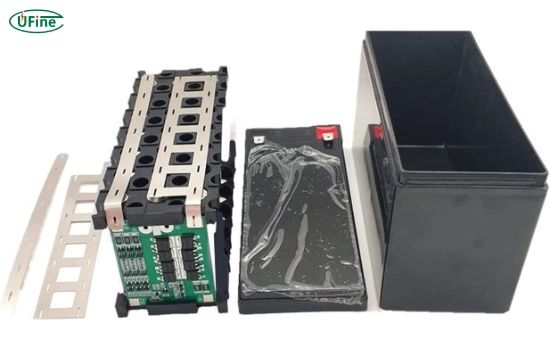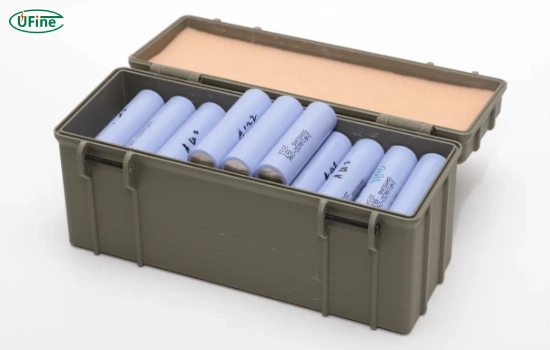How do you store 18650 batteries? This guide helps you keep them safe. Learn simple tips for good storage, safety rules, the right places, choosing containers, and safe transportation. Follow these steps to make your batteries last longer and safer to use!
Part 1. 18650 Battery safety guide
- Temperature Caution: T Extreme temperatures are a big no for 18650 batteries. Keep them away from excessive heat or cold to maintain their health. Aim for storage around 20°C to 25°C (68°F to 77°F).
- Handle with Care: Protect these batteries from physical harm. Store them in a safe spot, free from sharp objects or crushing pressure that could cause damage.
- Charge Smartly: Before storing, a 50% charge level is perfect. It stabilizes the batteries without risking overcharging or complete discharge, which can mess up their performance.
- Mind the Terminals: Cover the battery terminals with insulating material to prevent accidental short circuits, especially if stored with other batteries or conductive items.
- Mix No Batteries: Avoid mixing batteries of different brands, capacities, or charge levels in the same storage. It keeps things balanced and prevents any unwanted surprises.
- Special Containers: Use containers specifically designed for battery storage. They offer protection, prevent physical damage, and reduce the risk of accidental short circuits.
- Regular Checks: Take a peek at stored batteries now and then for leaks, swelling, or damage. If anything looks off, get rid of those batteries responsibly.
- Charging Cautions: Stick to chargers meant for 18650 batteries and avoid overcharging. It keeps them from getting too hot and causing trouble.
- Watch for Red Flags: If batteries show signs like overheating, emitting unusual odors, or swelling, it’s crucial to stop using them immediately and handle them carefully.
Part 2. 18650 Battery storage environment
- Temperature Stability: Maintaining an optimal temperature range between 20°C to 25°C (68°F to 77°F) is vital for preserving the quality of 18650 batteries. Extreme temperatures, either too high or too low, can negatively impact their performance and longevity.
- Humidity Control: Low humidity levels are preferred to prevent moisture-related issues. Storing batteries in a dry environment mitigates the risk of corrosion and ensures the integrity of the components.
- Ventilation Importance: Adequate ventilation in the storage area is essential. Proper airflow helps regulate temperature and prevents the accumulation of gases, minimizing the possibility of overheating.
- Sunlight Avoidance: Direct exposure to sunlight or UV rays should be avoided. Prolonged exposure can degrade battery materials, leading to diminished performance and a shortened lifespan.
- Keep Away Dust Debris: Protect batteries from dust and debris to minimize the risk of foreign particles interfering with their performance.
- Stay Clear of Magnetic Fields: Avoid storing batteries near magnetic fields as they can interfere with the battery’s components and alter performance.
- Stay Away From Chemicals: It’s advisable to store batteries away from potentially hazardous materials or chemicals to prevent any reactions that could compromise their integrity.
Part 3. 18650 Battery storage package
- 18650 Battery Cases: Opt for specialized battery cases or holders designed explicitly for 18650 batteries. These cases provide individual compartments, ensuring each battery is securely housed and prevents contact between terminals.
- Non-Conductive Materials: Choose containers made of non-conductive materials like plastic or silicone. These materials reduce the risk of short circuits and provide insulation against accidental contact with conductive surfaces.
- Cushioning and Protection: Look for containers with adequate cushioning to protect batteries from physical impacts or drops. Foam inserts or dividers inside the container help secure the batteries and prevent movement during transport or storage.
- Labeling: Prioritize containers that allow for clear labeling or identification. Properly labeling the containers with battery specifications or warnings helps in easy organization and identification of the stored batteries.
- 18650 Battery Wrap or Sleeves: Consider individual wrapping or sleeves for each battery within the container. This additional layer of protection prevents direct contact between batteries and minimizes the risk of short circuits or accidental discharge.
- Sealed Containers: Choose containers with secure closures, such as snap-lock lids or screw caps, ensuring the batteries remain safely enclosed and protected from external elements.
- Size and Capacity: Select containers that accommodate the number of batteries you intend to store without crowding. Avoid overfilling to prevent damage caused by excessive pressure on the batteries.
Part 4. Shipping 18650 batteries
- Packaging Considerations: Use appropriate packaging designed for shipping lithium-ion batteries. Opt for sturdy, non-conductive materials that provide cushioning against impacts, preventing damage during transit.
- Individual Battery Protection: Consider unique wrapping or placing batteries in protective sleeves within the shipping package. This prevents direct contact between batteries, reducing the risk of short circuits during transport.
- Container Selection: Choose containers that secure the batteries snugly to prevent movement within the package. Secure closures, such as snap-lock lids or screw caps, ensure batteries remain safely enclosed.
- Handling Precautions: Exercise care during handling to avoid dropping or mishandling the package containing the batteries. Fragile contents should be handled with caution to prevent damage.
- Separation from Metal Objects: Keep batteries separated from metal objects within the package to prevent accidental contact, which can cause short circuits or damage to the batteries.
- Labeling Requirements: Clearly label the package to indicate the presence of lithium-ion batteries. Include handling instructions and warnings and comply with carrier-specific labeling requirements for safe transportation.
Part 5. 18650 Battery charging and discharging
Partial Charging for Storage: Before storing 18650 batteries, it’s advisable to charge them partially, aiming for around 50% capacity. This partial charge helps maintain stability during storage without risking overcharging, which could harm their longevity.
- Charger Compatibility: Use chargers designed explicitly for 18650 batteries. Using incompatible chargers or rapid-charging methods might compromise their integrity, impacting performance and lifespan.
- Avoid Overcharging: Overcharging poses a significant risk to these batteries. Once they reach total capacity, promptly remove them from the charger to prevent potential damage caused by overcharging.
- Discharge Levels: Avoid the complete discharge of 18650 batteries, as it could cause irreparable damage. Maintain them at recommended levels to safeguard their capacity and health.
- Regular Usage: Periodically using these batteries, even during storage, helps maintain their condition. This practice prevents stagnation and ensures continued functionality over time.
- Storage Conditions Post-Charging or Discharging: After charging or discharging, store the batteries in a cool, dry place away from direct sunlight. Maintaining them at a partial charge level before storage is crucial for their overall health during the storage period.
- Avoid Rapid Charging: Rapid charging generates excess heat, potentially harming the batteries. Stick to moderate charging rates recommended by the manufacturer for safer and more effective charging.
Part 6. FAQs
-
How do you prolong the life of an 18650 battery?
To extend the life of an 18650 battery, avoid deep discharges, use compatible chargers, store at moderate temperatures, avoid extreme temperatures, and don’t overcharge or over-discharge the battery. -
How long do unused 18650 batteries last?
Unused 18650 batteries can retain their charge for several months or longer, depending on their quality and self-discharge rate. Generally, they might hold a charge for six months to a year, but this can vary. -
Why do 18650 batteries need to be wrapped?
Wrapping 18650 batteries helps protect them from physical damage and prevents short circuits by insulating the metal casing. Re-wrapping is essential if the original wrapping becomes damaged or compromised. -
Is it wrong to leave 18650 on the charger?
Leaving an 18650 battery constantly on a charger after it’s fully charged can degrade its performance over time. Removing the battery from the charger once it reaches total capacity is advisable to prevent overcharging. -
Why do you need to tape the ends of batteries?
Taping the ends of batteries, significantly if the original wrapping is damaged, prevents accidental short circuits by covering the exposed terminals. This helps ensure safe handling and usage of the battery.
Related Tags:
More Articles

LiPo Battery Discharge Rate Guide & Calculation Tips
Understand LiPo battery discharge rates, C-ratings, and how to calculate max current. Essential guide for RC, drones, and electronics users.
High‑Capacity 3S LiPo Batteries: 5000 mAh vs. 10000 mAh
Compare 3S LiPo 5000mAh vs 10000mAh batteries by weight, power, and use. Find the best fit for your drone, RC car, or boat setup.
Top 5 Applications for Small 3S LiPo Batteries
Small 3S LiPo batteries power drones, RC gear, wearables, and robotics with high energy and low weight. Making them ideal for compact electronics projects.
Building and Charging Your Own 3S LiPo Pack: A Step‑by‑Step Guide
Learn how to build, balance, and charge a 3S LiPo battery pack safely at home with this complete DIY guide for hobbyists and beginners.
How to Choose the Right LiPo Battery Plug Type?
Discover the best LiPo battery plug types, how to choose them, and expert tips for safe usage, soldering, and maintenance.





